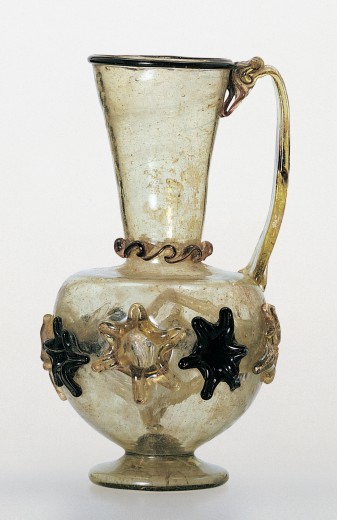



Title: Jug
Date: 11th–12th century AD
Location: Iran or Afghanistan
Materials: bubbly, pale yellowish-green glass with amethyst trails; blown, trail-decorated and tooled
Dimensions: 18.2 x 10.2cm
Accession Number: GLS 570
Other Notes:
The jug has a globular body with flattish shoulders, a small base and a tall flaring neck. The applied handle is attached to the rim and the shoulders. The splayed foot is pushed in and retains a pontil mark.
The interest of the jug lies not in its form, but in its decoration. Around the body are eight rosettes, alternating in yellowish-green and deep amethyst glass. The centres of the amethyst rosettes have been pushed into the body of the vessel, creating tooled tubes that meet at the centre of the jug. The yellow-green rosettes are similarly tooled, but each is pierced twice so that four tubes point upwards from the centre and four point towards the base. There are no known Islamic parallels for the treatment of these inner tubes, although in some Roman vessels tubes run across the entire width of the body. There are amethyst-coloured trails around the lower part of the neck, and the mouth.
In 19th-century Iran the interiors of glass bottles were sometimes decorated with trees or flowers made of coloured glass. If the tubes in the present piece actually had a function, they could perhaps have served as filters, although they can scarcely have been as efficient as a filter in the neck. Alternatively, the piece may have been some kind of trick vessel.
Bibliography:
S.M. Goldstein et al, Glass. From Sasanian Antecedents to European Imitations, The Nasser D Khalili Collection of Islamic Art, volume XV, London 2005, cat.71, pp.74–5.
Zoom
Close

Create your own collection of artworks that you can print or save as a PDF. Please enter you email to enable feature.
Small Flask | JLY 1075
Has been added to your collection.
TIP:
You can now access and view your collection from the main menu at any time.